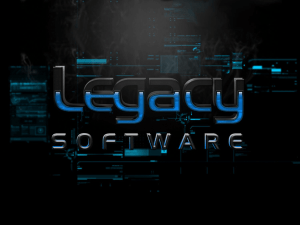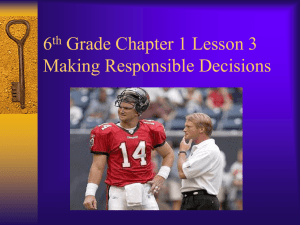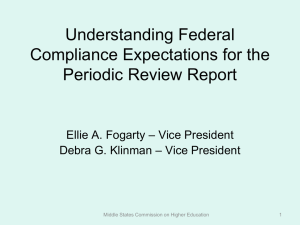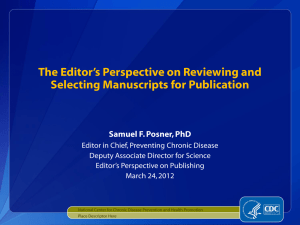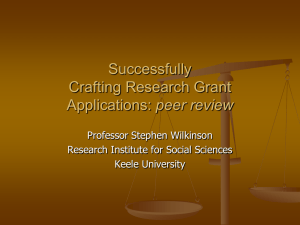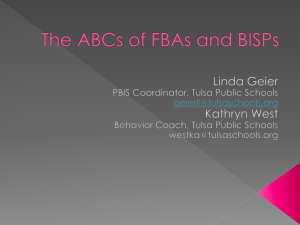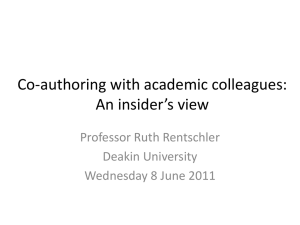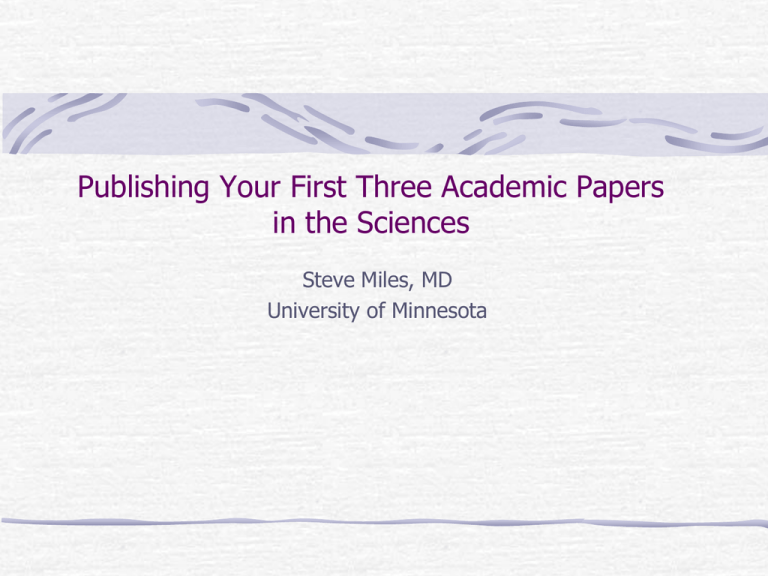
Publishing Your First Three Academic Papers
in the Sciences
Steve Miles, MD
University of Minnesota
Caveats
This course is about
writing for academic publication.
It is not about creative writing, study
design, human subjects protections,
statistical methods, etc.
A Basic Personal Library on Writing.
Writing
Composition
Marketing
BUT, Writing is not
“Writing for Academic Publication.”
Get a Good Dictionary!
A dictionary is not just a spellchecker.
Effect v affect
Denote: indicate
“flashing yellow denotes caution”
Connote: imply
“hospice should not connote giving
up”
Etymology: a word’s origin adds
resonance to your writing.
Palliate comes from pall, appall,
pale.
I: What is Writing for
Academic Publication?
Academic Writing is / is not
Academic Writing
Journal articles
Editorials
Letters to academic
journals.
Peer reviews
Grant Applications
Personal Writing
Journaling
Poetry, Haikus,
Limericks
Memos
Personal letters
Writing has different aims than
Academic Writing.
Writing
Self expression.
Personal problem solving.
Maintain personal relationships.
Recreation.
Academic Writing is Published
To
To
To
To
change minds, policies.
build or sustain professional networks.
advance a career.
earn money.
Academic Publishing
Connecting your passion to an audience
to make things happen.
What are you
passionate about?
Who/Where is
your audience?
What can you
make happen?
Getting Started: Find your passion.
Do I care?
Why do I care?
How can I get someone else
to else care?
What do I want this paper to
accomplish?
Getting Started: Find your audience.
Journals you admire/know.
Writers you admire on same topic;
Where are they publishing?
Medline
Search your topic for last 3-5
years
Sort by journal name.
Voila!
Find your audience (An editor who shares your passion):
Who publishes on HIV Screening in Prisons?
#
1
Searches
HIV Infections
Results
193,706
2
Prisons
6,630
3
Mass Screening
83,260
4
1 and 2 and 3
limit 4 to (english language and
yr="2005 - 2010")
50
5
17
Partial output: Who cares about HIV
Screening in Prisons?
AIDS & Public Policy
1.
1.
HIV testing in correctional institutions: evaluating existing strategies, setting new standards. 2005 SpringSummer:
AIDS Policy & Law
2.
1.
Testing. Delaware proposes to test all inmates for TB, hepatitis and HIV. 2006 May 5.
American Journal of Public Health
3.
1.
HIV/AIDS and other infectious diseases among correctional inmates: transmission, burden, and an appropriate
response. [Review] [73 refs] 2006 Jun.
Clinical Infectious Diseases
4.
1.
2.
3.
Routine HIV testing in jails is critical for the early diagnosis of HIV infection in men. 2008 Nov 15.
Opportunities to address the hepatitis C epidemic in the correctional setting. 2005 Apr 15
Is routine testing mandatory or voluntary?. 2005 Jan 15
Sexually Transmitted Diseases.
5.
1.
2.
3.
Rapid HIV testing in rapidly released detainees: next steps. 2009 Feb
Sexually transmitted infections and HIV prevalence among incarcerated men who have sex with men, 20002005. 2009 Feb
Responding to the burden of STD, HIV, and viral hepatitis in correctional populations through program
collaboration and integration. 2009 Feb
Market in AIDS, STD, or Public Health Journals.
Assignment 1
Write a one page argument in which
you take a position.
Underline the topic sentence of each
paragraph.
Submit by email two days before the
next class.
II: The Literature Search
The Foundation: Your Literature Search.
Your arguments about the
newness of your findings and
soundness of methodology rest on your lit search.
Search the topic very carefully with Medline,
web, news and citation tracking, etc.
Search reviews on your method: e.g., metaanalysis, cost-effectiveness studies, qualitative
research.
Do not use proforma citations of classic works.
Reviewers can tell!!
And/Not
Pets that are Snakes (except Constrictors)
Pets
AND
AND
Not
Constrictors
NO WAY!
Snakes
Or/Not
Birds or Snakes (But not Constrictors)
Birds
Snakes
Not
Constrictors
Search: Key Words v Text Words
#
Searches
1
Resuscitation orders
2774
2
DNR.mp.
1709
3
(do not resuscitate).mp. [mp=title, abstract, original title,
name of substance word, subject heading word, protocol
supplementary concept, rare disease supplementary
concept, unique identifier]
4
"do not resuscitate".mp.
Results
438119
1026
Iterative Dynamic Search:
Using ‘Complete Reference’ to find search terms.
In the course of a search, look
at the highly relevant articles
Complete Reference
Do any of these search
terms give you ideas?
If so, redesign and
rerun your search.
Characteristics of cancer patients who refuse
do-not-resuscitate orders.
Cancer. 116(12):3061-70, 2010.
Adult
African Americans
Cancer Care Facilities
Case-Control Studies
Female
Humans
Male
Middle Aged
Nausea / co [Complications]
Neoplasms / di [Diagnosis]
Neoplasms / mo [Mortality]
Pain / co [Complications]
Palliative Care
Patient Acceptance of Health Care
Resuscitation Orders
Retrospective Studies
Survival Analysis
Iterative Dynamic Search Citations: Method II:
Take a relevant article and
note new articles that you
missed in its citations
Add that article to your file.
Look it up on PubMed or
Medline to see its Complete
Reference
Take the new search terms and
redesign your search.
Characteristics of cancer patients who refuse
do-not-resuscitate orders.
Cancer. 116(12):3061-70, 2010.
Adult
African Americans
Cancer Care Facilities
Case-Control Studies
Female
Humans
Male
Middle Aged
Nausea / co [Complications]
Neoplasms / di [Diagnosis]
Neoplasms / mo [Mortality]
Pain / co [Complications]
Palliative Care
Patient Acceptance of Health Care
Resuscitation Orders
Retrospective Studies
Survival Analysis
Assignment 2. Lit search
Send me the screen dump of the search
strategy that you used to find literature
on a topic of your choice.
Tell me what you were looking for in
the subject line of your email to me that
contains the search.
Submit by email two days before the
next class.
III: Good Papers are
Well Written
Murder your darlings.’
“Style is not—can never be—extraneous
ornament.
Whenever you feel an impulse to perpetrate a
piece of exceptionally fine writing, obey it—
whole-heartedly—and delete it before
sending your manuscript to press. Murder
your darlings.”
Sir Arthur Quiller-Couch
On the Art of Writing. 1916.
Mark Twain Letter to D. W. Bowser, 3/20/1880
I notice that you use plain, simple language, short
words and brief sentences. That is the way to write
English. … Stick to it; don't let fluff and flowers and
verbosity creep in.
When you catch an adjective, kill it. No, I don't mean
utterly, but kill most of them - then the rest will be
valuable. They weaken when they are close together.
They give strength when they are wide apart. An
adjective habit, or a wordy, diffuse, flowery habit, once
fastened upon a person, is as hard to get rid of as any
other vice.
A Grammar Checker won’t make you a great writer.
(But it can stop you from being a turgid one.)
Passive sentences
Keep less than 20%
Active is shorter and more fun to
read.
Flesch Reading Ease:
should be over 60 (easily read by
13 year olds)
F-K Grade Level : 13 or less.
Gettysburg Address is 69 and 9.1
Law school tenure policy 23, 16.6
Use the Grammar Checker on each section of your
paper in addition to the whole paper.
Writing Tips
Average sentence: < 15 - 17 words.
Paragraph:
40 - 70 words
3 - 7 sentences
Must have a topic sentence! (Until
you can do so by instinct, underline each
topic sentence.)
Eradicate word-milfoil!
Also, while it is true…
It is a fact that…
To me, …
It is my opinion that…
Modern science shows…
Current research finds…
For example, consider the case of, …
Reduce wordiness.
Patent law defines that
products of nature are
beyond the scope of a
patentable subject matter.
On the other hand, the
opponents of Euthanasia
have a different standpoint,
they argue that…
Framing the question this
way distorts the important
practical issue at hand.
Products of nature are not
patentable by law.
Opponents of euthanasia
argue that …
This framing distorts the
practical issue.
Non-Working sentences
drive readers away
Reasons are many; literature is
cluttered with them.
This is an important issue.
Topic sentences should tell the
reader what this paragraph is about.
Randomized control trials are a fundamental aspect
of approving new pharmaceuticals for market.
However, with the pharmaceutical industry pulling in over
$300 billion annually, the temptation to circumvent scientific
merit is ever present. When determining the efficacy of a
drug, the FDA insists that a drug is at least 5% more
effective than a placebo. However, little attention is paid to
the scientific validity of the placebo group. Special regard for
placebo composition needs to be taken in order to ensure
that pharmaceutical trials stand up to rigorous scientific
review.
Do not create unfulfilled expectations.
Cover each point in your list.
The use of unmanned aerial drones by the US
military and CIA to execute alleged enemies of
the US is unethical, unconstitutional, and
undermines its credibility as a source of global
leadership, justice, and integrity.
Mandated insurance coverage for services related
to Autism Spectrum Disorder (ASD) is the duty of
any society that values the lives of children.
One idea per paragraph
Health information exchange can succeed without resorting to a single medical
identifier. Alternative approaches put patients in control of their own medical
records. Patients own their healthcare data and are at the center of requests to
link or release it. This requires patients to be actively engaged. Just as use of a
patient’s healthcare data without their permission is unacceptable, so too is
patient apathy toward how their healthcare data is used. We put our trust in
our medical professionals. We do not turn over control of our rights or
responsibilities when we engage the healthcare system. Unique medical ids
make it easier for healthcare organizations, insurance and government
agencies to forget that an individual person is behind every piece of medical
information. Certainly many will permit the use of their data for research, or
prefer, for example, that any provider can access their records in an
emergency. In all cases, patients should set the rules about what information
should be shared and under what circumstances. Proponents correctly claim
that a UPI would make data exchange easier. A patient’s right to privacy is
more important than the convenience of the healthcare industry.
Add specificity
The result is that one in three people
killed by a U.S. drone in Pakistan has
been a civilian, with at least 1700 dead
(a conservative estimate).
According to the Defense Department,
1700 civilians have died in U.S. drone
attacks in Pakistan; conservatively a
third of drone casualties.
Fact check every assertion.
Private payer or well-insured patients
have access to a coveted awareness of
gene mutations to guide early
intervention. The class of patients tied to
state coverage or without insurance
altogether is deprived of this potentially
life-saving knowledge.
Hot rhetoric weakens a paper.
I am appalled. I am beyond appalled.
The current protection of intellectual
property has manifested a monster
which is impossible to overcome
without radical changes in the current
patenting system.
Hot rhetoric weakens a paper.
…fertile females … are pumped full of extra hormones
over the course of a month to develop and mature an
unnatural number of eggs for harvesting. The eggs are
then removed during an outpatient procedure and the
donor is sent on their merry way to heal and recover
from the physically traumatic process. … Donors include
young college girls who typically are strapped for cash
and are easily influenced by the disguise of a good deed.
Unbeknownst to most of them, however, they are being
used and manipulated by desperate and rich infertile,
wannabe parents.
Ungrounded moral exhortation is
not an argument.
overlooks the moral imperatives of society
to care for the needs of citizens.
the right to end a painful, impaired living
with absolutely no expectancy to benefit
from a discovery of a cure in short term, is
a free will and justified by the same
constitutional laws that protects other
rights.
Use pronouns to shorten text.
It is quite possible the patient or research
participant will disregard all or a portion of the
presented information, which is often technical
and complicated.
They might disregard some or all of the technical and
complicated information.
The implicit first person is unnecessary.
I believe that gene patents are morally wrong and should be
stopped in their current form. I argue that the current
patent system does not promote science; instead it
promotes and rewards unethical behavior. I recommend a
patent system that promotes science, rewards inventors,
benefits society, and introduces mechanism for publicly
discussing ethical issues..
An argument cannot be built by
piling up rhetorical questions.
Is it fair that one physician is paid differently for the
same work because of where he chooses to practice?
Wouldn’t it be more just to pay the Mexican physician
who earns $50,000 annually the same as the US
physician who earns $250,000? Is it fair that a
physician is compensated for a presentation based on
what they earn for treating patients? Wouldn’t there be
greater confidence and trust if patients knew that
physicians were earning less for collaborating with
industry than in practice? …
Read Your Drafts out loud!
PS: A publishable paper will have 15-40 drafts!
Find yourself a quiet room.
Polishing
Cannot be done enough.
Start at various points in the paper as
you write. (Avoid a polished start and a
rough middle.)
Relying on a spell checker is like staring
at a GPS and ignoring detour signs.
Getting Past Writer’s Block
Outlines.
Network of ideas mixing text and
glyphs (asemic writing).
Free writing.
Meditation (automatic) writing
Note cards.
Inspiration capture., e.g., text yourself,
notepad in pocket or next to your bed.
They all can produce a scientific paper.
Write from your passion—the scientific form comes during
editing.
IV: What is Authorship?
Authorship: Unitary Model
Substantial Contribution to:
Conception.
Design.
Drafting intellectual content.
Complex data acquisition.
Analysis.
Final guarantee of claims.
Authorship: Contributor Model
Each Guarantor-Author takes overall responsibility
for the paper as a whole.
Each Contributor-Author has a disclosed substantial role:
Conception.
Design.
Drafting intellectual content.
Complex data acquisition.
Analysis.
Types of Misconduct Seen by a
Dispute Resolution Committee
Acta Onco 1999;38:89-92
Retracted Papers
Proceedings of National Academy
of Science 10/1/12.
J Med Ethics 2011; 37:56770. All retractions from
Cut Authorship Fights off at the Pass!
The lead author is project
manager, director, screenplay
writer, producer.
Author assignment, evaluation
and ranking should be
continuously updated in writing.
No paper should be submitted with an open
authorship conflict.
Acknowledgements
Contributors not meeting authorship criteria.
Persons providing purely technical help, writing
assistance
Department chair who provided only general
support.
Persons who contributed materially to the
project but not as authors, e.g., “participating
investigators” with descriptors of their function
Financial and material support should also be
acknowledged.
All persons must give written permission to
be acknowledged.
Honorary Authors
• Acquisition of funding,
• Collection of data,
• General supervision of the
research group alone
Does not constitute authorship.
V: Conflicts of Interest
Conflicts of Interest
Financial: “I have a financial interest in
this paper being published.”
Intellectual: “I cannot be intellectually
fair to this topic.”
Institutional: “My institution has
exercised its authority over the content
of this paper.
Control of authorship—ghostwriting.
Favorable Outcomes of Corporate v Independent
Research Published in JAMA, LANCET and NEJM
N=39, p.=07
N=104, p.001
N=205, p.002
JAMA 2006;295:2270-74.
Open Access Conflict of Interest
Authors pay
publishing fee.
Profit making.
Meet authors
need to publish.
Science editor submitted 304
versions of paper with fake
names, fake institutions, bad
science claiming anticancer
effect of tree mold.
167 acceptances by “peer
reviewed” Open Access journals,
even those not covering the
field.
Science: 2013;342 (6154): 60-5.
Ghost Authors
People who write the paper
behind the scenes without
attribution:
Drug or medical device
companies or their PR
departments.
Special academic assistants.
Undisclosed conflicts of interest.
Plagiarism
Punished by editorial death!
Steve’s Scandal Rag
Corporate Ghostwriters
75% in industry-sponsored
trials. (JAMA 2008;299
1800-12.)
Refoxecoxib (Vioxx) 50% of
review ghost authors
disclosed support. JAMA
2008;299-1800-12
Ghostwriter: “I was given
explicit instructions about
what to play up and what
to play down—whether to
enhance broader off-label
use of the pain product or
go strictly by the FDA.”
Lancet 1999;354:136.
Note to self: Editors call
ghostwriting:
Undisclosed conflicts of
interest
Plagiarism
and punish it with editorial
death!
Conflicts of Interest- Peer Review
Financial: “I have a financial interest.”
Intellectual: “I cannot be intellectually fair
to this topic.”
Institutional: “My institution has exercised
its authority over the content of this
paper.
Collaboration conflict—not known to
editor. (e.g. author is your student,
colleague.
Breach of confidentiality of review.
Avandia – 9/2010
Sales begin.
Divided vote,
poor data on
risks. Minority
report
dissents.
1999
WHO warns about
heart effects.
GSK ordered to post unpub
trials because of corporate
suppression of data on
antidepressant suicides.
2004
2005
NEJM Meta-analysis
shows 43% heart
attack. Extra
deaths~ 47,000. (A
peer reviewer leaked
review to Glaxo.)
FDA: Stronger label.
2006
2007
GSK internal study
(that ignores some
MIs) finds 31%
heart attack.
P=NS. GSK
conceals memo.
BMJ 2010:341:c4848.
1 Million Rxs, Sales from
22%
$3B to $1B/Yr.
BMJ: Risks> benefits;
withdraw it. UK: Ditto.
Europe stops sales.
FDA restricts sales;
divided vote (Avandia
speakers vote).
2010
GSK to European Heart
Journal: “Withdraw this
editorial (critical of Avandia)
and refrain from publishing it
in any way.”
Sales:$500
M/Yr.
Conflicts of Interest
Seek the Oracle. International Committee
of Medical Journal Editors
http://www.icmje.org/
Disclose all.
Violators will be punished.
Assignment
Find me a really bad graph that applies
to your field.
VI: Graphs, Charts, Tables
The purpose of graphics is to
communicate a point, not to display data!
Rules for Visual Data Display
As with text, the purpose of a
graph or table is to carry your
argument forward.
Clear and Simple.
Honest
“Kill your darlings”
Graphs should tell an instant story: This one does.
The US health care system is expensive.
PER CAPITA SPENDING ON HEALTH CARE
$/yr
OECD 2009: 2007
The Organization for Economic Cooperation and Development was founded in 1961 to
compile statistics and policy reports to promote economic growth.
Graphs should tell an instant story: This one doesn’t.
Out Of Pocket drug costs: compliance.
Health Aff 2008;27:89-102
Bubble Size = % non compliant with meds
Vanishing Point
Distortion
2-D Distortion of 1-D Data
A clean chart says more.
Are the treatments better than placebo?
This is the same data!
Use Honest Charting
Worse
Better
Months
Actual chart from a drug company study showing
how a drug improved dementia scores.
Months
Same Data!
Huh?
Confusing Cute
Cute: Chart or Table?
300,000
600,000
900,000
600,000
300,000
900,000
Complex Graphics
A complex graph should tell a story.
3 D Charts should tell a
3 Variable Story.
Nope
Yep
The Greatest Chart Ever Made!
Temperature during retreat
Is there a story here?
Multidimensional
Graphs
Eschew Obfuscation
A Good Table, like good text, tells a story.
Change and difference sizzle.
Counts say little.
Alphabets are not variables:
Sort on important variable.
Vary typeface or insert
markers to make points.
Avoid excessive or pseudoprecision 3.1672.
If it can’t be grasped, it won’t
be read.
Klass G. Presenting Data: Tabular and
graphic display of social indicators,
2002. http://lilt.ilstu.edu/gmklass/pos138/d
atadisplay/sections/goodtables.htm
Bad Tables, like bad graphs, show off but do
Keep them simple with
not communicate.
common terms and clear
conclusions.
If a reviewer/reader can’t
grasp it quickly, they will not
look at it.
A table like this can move
your paper from a high
circulation journal to a small
circulation, specialized
journal.
Complex data should go as
online appendix
This necktie would fit the
mentor who told me to
try to publish this table!
VII: Assembling the Whole Paper
Step 1, 2, 3: Consult Oracle.
VII: The Whole Paper
Title
IDs
Keywords
Abstract
Introduction
Methods
Results
Discussion
References
Appendices for data
Title and Search Terms
Titles
Avoid cute titles for
academic publications.
Avoid rhetorical claims:
“A revolutionary advance
in living wills.”
Keep them short.
Journal titles should avoid
subtitles. Brain Death:
New Perspectives
Search Terms
Don’t bury your work alive!
If keywords are
requested, use Medline,
MeSH keywords.
Do not dream up your
own.
It is always OK to
suggest search terms to
the editor with the MSS.
Introduction
Set the context.
Be succinct; not a
review.
Define the starting point
for your work.
State what you are out
to do (or find).
State why it matters.
Methods
Hypothesis
Sample selection
Power calculation
Variables, measurement tools,
and instruments.
Statistical tests and/ relevant
software.
On line data appendices.
Everything someone would
need to duplicate your work.
Content
Results
The sequential application
of your method.
Sample collection,
exclusions, final
population.
Standardization.
Comparisons
Graphics
Etiquette
No analysis! (Save it for
the discussion.)
No reference to past
studies (especially your
own).
Discussion
Content
Etiquette
Discuss what you add to
the (previously stated)
context).
State the limitations.
Discuss its utility,
importance, value.
Discuss future research
that might confirm or
elaborate on this work.
Minimize self citation (It
even annoys reviewers).
Do not repeat data or
introduction.
Write the Abstract Last!
Avoid Contradiction.
“Many abstracts disagree with
the text of the article.”
Avoid non-therapeutic
amputations.
Abstracts are the online
content of your article.
Follow length rules!
Evolution of tropomyosin functional domains:
differential splicing and genomic constraints.
We have cloned and determined the nucleotide sequence of a
complementary DNA (cDNA) encoded by a newly isolated human
tropomyosin gene and expressed in liver. Using the least-square
method of Fitch and Margoliash, we investigated the nucleotide
divergences of this sequence and those published in the literature,
which allowed us to clarify the classification and evolution of the
tropomyosin genes expressed in vertebrates. Tropomyosin undergoes
alternative splicing on three of its nine exons. Analysis of the exons
not involved in differential splicing showed that the four human
tropomyosin genes resulted from a duplication that probably occurred
early, at the time of the amphibian radiation. The study of the
sequences obtained from rat and chicken allowed a classification of
these genes as one of the types identified for humans. The divergence
of exons 6 and 9 indicates that functional pressure was exerted on
these sequences, probably by an interaction with proteins in skeletal
muscle and perhaps also in smooth muscle; such a constraint was not
detected in the sequences obtained from nonmuscle cells. These results
have led us to postulate the existence of a protein in smooth muscle
that may be the counterpart of skeletal muscle troponin. We show that
different kinds of functional pressure were exerted on a single gene,
resulting in different evolutionary rates and different convergences in
some regions of the same molecule. Codon usage analysis indicates
that there is no strict relationship between tissue types (and hence the
tRNA precursor pool) and codon usage. G + C content is characteristic
of a gene and does not change significantly during evolution.
(ABSTRACT TRUNCATED AT 250 WORDS)
To cite or not to cite: Don’t cite.
Indisputable facts.
There are billions of stars.
Eponym ideas
E.g., Boyle’s Law
Except when critiquing the seminal work,
This paper discusses a unrecognized error in Hubble’s
Constant.]
Cliches (a nod, not a cite)
As Descartes said, “I think therefore I am.”
To cite or not to cite . . ., Cite
Disputed truisms (no matter how ‘self evident.’)
Crack babies have life-long learning disabilities.1
Sources to blow up myths.1
A Christian Socialist wrote the Pledge of Allegiance in 1892 to sell
flags to schools. Bellamy regarded capitalism as the idolatry of
greed and therefore inherently hostile to equality.1 Congress added
the words “Under God” in 1954 during the McCarthy era to
express opposition to atheistic communism.1
Unusual ideas.
This paper evaluates whether the fall in crime is due to greater
access to abortions between 1975 and 2000.”1
Quotations.
To cite or not to cite. . . Hard cases.
• Secret source (discuss with editor).
• Research data files (offer to append on
line).
• Newspaper letters or opinion pieces or
journal editorials (usually invited).
•
Include fact checking list in cover letter to editor.
Authorities
International Committee of
Medical Journal Editors
Uniform Requirements for
Manuscripts Submitted to
Biomedical Journals.
Seek. http://www.icmje.org/
Bookmark.
Obey.
Violators will be punished.
Instructions for
Authors
Beware publishing
fees.
VII (a): Submitting your Paper:
The Cover Letter
Assignment: Write A Cover Letter
Address it to a particular named
professional publication.
It should conform to that journal’s Instructions to
Authors.
Dream up the content of the article that you are
submitting with it.
It should conform to all of the instructions in this
section of the course.
Academic Publishing
Connecting your passion to an audience
to make things happen.
What are you
passionate about?
Who/Where is
your audience?
What can you
make happen?
The Cover Letter is a Job Application for Your Paper!
One page TOPS.
2-3 sentence synopsis, 50
words TOPS (not the
abstract).
“This submission is
Perfect for your readers.
Perfect for your brand.”
Mandatory content from
the Oracle (ICJME).
Thy Chatty and Friendly Cover Letter!
Promises
The cover letter should be
friendly and collegial, not stuffy
and pretentious. “Business
casual.”
It should pique interest, show
professionalism and invite a
conversation.
This is not being considered
by any other journal.
This paper has not been
previously submitted to your
journal (or if it has why you
have the gall to resubmit).
No conflicts of interest or they
are disclosed per your policy.
Copyright.
FOLLOW INSTRUCTIONS FOR
AUTHORS!
Re: Torture Survivors: Screening, Assessing, Referring
Dear Dr. Sussman, (Journal of Family Practice)
The enclosed article is the only article that I am aware of that
comprehensively discusses the role of the primary care physician in
identifying and referring torture survivors. There are about as
many torture survivors in the United States as persons with
Parkinson’s disease. Accordingly, even physicians who do not
undertake the treatment of such persons should be familiar with
case finding and referral.
Should you wish, I do have a PowerPoint slide set of this material
and can offer a stable link to this slide set at my faculty page at
the University of Minnesota.
Sincerely, Steven H. Miles, MD
Suggesting Reviewers
Quality of peer review is comparably high.
Acceptance recommendations are higher.
Avoid conflicts of interest.
Not your institution, teacher, etc.
J Peds 2007;151:202-5.
JAMA 2006;295:314-7.
Never Make an Editor Mad at You!
Thou shalt not
Simultaneously submit the same
piece to two journals.
Publish the same piece twice (no
matter what media).
Violate embargo dates.
Editors never forget.
VII(b): Submitting your Paper:
behind the black box
Peer Review
Editorial Board
Yes?
Author
Editor
No!
Plan B.
ASAP!
Poor quality.
Peer Reviewers
Section
Not my
audience.
Editor
Not a prestigious author for us.
I am mad at you.
Section
Not timely.
Editor
Peer Review
Author
Editorial Board
Editor
Section
Editor
Section
Editor
Reject.
Reconsider with Revisions.
Accept with Revisions.
Accept.
Peer Reviewers
VII(c): Dealing with Rejection
Don’t take it personally
or you wind up . . .
Editorial or Analytic Papers
Reviews: Narrative
or Meta-analysis.
Academia and Clinic
Clinical Guidelines
and Position Papers*
Health Policy
Editorials*
Essays (history,
patient care, poems,
travel, bios
Case Reports
Quality
Improvement
Letters
Book Reviews
* Usually solicited or submitted by an institution.
Far East Economic Review
"We have read your manuscript with boundless
delight. If we publish your paper, it would be
impossible for us to publish any work of lower
standard. And as it is unthinkable that in the next
thousand years we shall see its equal, we are, to
our regret, compelled to return your divine
composition and to beg you a
thousand times to overlook our
short sightedness and timidity."
Why do papers get rejected?
Paper factors
Out of date.
Don’t procrastinate.
Flawed lit search.
Flawed methods. 16%
Poorly written.
36%!
Grumpy reviewers are
not friendly.
No passion.
Nor are bored reviewers.
Journal factors
So many submissions
-- so little space.
Just published on this.
Not our audience/issue.
22%
Bad luck with
reviewer/editor.
Dealing with Rejection
Is it really a rejection?
(Some are, “We can’t take
this paper but revise and we may take another look.”)
What can you learn from the reviews?
Are the criticisms about
the paper or
about its fit with the journal’s audience?
Papers in minor journals can have MAJOR
influence.
Dealing with Rejection
Read the paper aloud.
Does it flow as well as I thought it did?
How many grammar mistakes were
there, really?
Does it convey my passion?
Did I speak to the journal’s audience?
Dealing with Rejection.
Have your next journal in mind
when you submit a paper.
Re-edit to reviewers’ comments.
Update literature search!
Resubmit ASAP (you have put a lot
of work into this).
My personal record is 17 rejections for one paper not counting
the dead papers lying on my hard drive.
VII(d): Acceptance
(is not the final stage.)
Acceptance is an Emergency!
Answer queries and complete various
forms on same day if possible.
Your paper may be timely—e.g., delay
can harm its inclusion in a special issue.
Then relax!
VIII: Peer Review
Peer Review
Is this paper for
my journal, my
audience?
Topic
Author
Depth
Peer Review
Is it important?
Is it relevant to the journal?
Is it sound?
It is well written?
Are the references up to date/well chosen?
Should be accepted, revised, rejected?
Are you willing to reread?
Are you willing to write commentary?
Books and Theses
IX: THE BIG MANUSCRIPT
Coherence, Balance, Organization
Story Boards
Outlines
Dynamic Tables
of Contents
Subdocument for
each page.
Title
Topics
Words
Target
Intro
How I got to 1800
subj, Methods
2000
Ch 1
Torture
3108
3000
Ch 2
Med and
Torture
2967
3000
Part I
Part II
…
Totals
69745
75000
BACK UP
X: Building a Career with your
Academic Papers
Summary of Course
Definition/Purpose
of Academic Writing.
Find your audience
Literature Searching
Authorship
Conflicts of Interest
Effective Writing
Effective Graphics
Elements of a paper.
Introduction,
Methods, Results,
Discussion
Abstract, Title
Submitting paper
Cover letter
Rejection/acceptance
Peer Review
Big Paper
Anthologizing and Spinoffs
Collect articles
by you or others
for an anthology,
add commentary,
etc
Restructure and
update chapters
for publication
Plagiarism/self plagiarism
Others
Web is poison to
this.
Least publishable
unit and salami
publications.
Self referential work
Repeating yourself
After the Publication:
Connecting your passion to an audience
to make things happen.
Scientific
Meetings
Academic
Lectures
Follow-up
confirmatory
or outcome
papers.
Legislative
testimony
Community
Education
Op-ed pieces
Legal work
BRAND
At least
three times
on Each
topic.
Present at
Academic &
public
meetings.
Peer
Review—
openly.
Readings
International Council of Medical Journal Editors http://www.icmje.org/
Holmes DR Jr, et al. Manuscript preparation and publication. Circulation.
2009;120(10):906-13.
Turka LA. J. After Further Review. J Clin. Invest. 2009;119:1057.
Ushma N. How to write an effective referee report.
J. Clin. Invest. 1195 http//www.jci.org/articles/view/39424/pdf
Skandalakis JE. Mirilas P. Plagiarism. Archives of Surgery. 2004; 139(9):1022-4.
Anonymous. Self-plagiarism: unintentional, harmless, or fraud? Lancet 2009;
374(9691):664.
Irwin RS. The role of conflict of interest in reporting of scientific information. Chest
2009 136(1):253-9.
Davidoff F, et al Sponsorship, authorship, and accountability. JAMA 2001;286:12324.
Angell M, Relman AS. Redundant publication. New Engl J Med 1989;320:1212-4.
Slides available on request.
Steven H. Miles, MD
University of Minnesota
miles001@umn.edu

